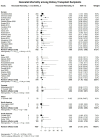Pregnancy outcomes in renal transplant recipients: A systematic review and meta-analysis
- PMID: 39287599
- PMCID: PMC11418342
- DOI: 10.1177/17455057241277520
Pregnancy outcomes in renal transplant recipients: A systematic review and meta-analysis
Abstract
Background: Kidney transplantation is a superior treatment for end-stage renal disease (ESRD), compared with hemodialysis, offering better quality of life and birth outcomes in women with ESRD and lower fertility rates.
Objectives: To investigate the pregnancy, maternal, fetal, and graft outcomes following kidney transplantation in women with ESRD and evaluate the improvements in quality of life and associated risks.
Design: A systematic review and meta-analysis performed according to the Preferred Reporting Items for Systematic Reviews and Meta-Analyses and the Meta-analysis of Observational Studies in Epidemiology guidelines.
Data sources and methods: A thorough search of multiple databases, including PubMed, Embase, Scopus, ATC abstracts, and Cochrane Central Register of Controlled Trials, was conducted to identify studies that analyzed pregnancy outcomes in kidney transplant patients. The search was conducted from the inception of each database to January 2023.
Results: The study reviewed 109 studies that evaluated 7708 pregnancies in 5107 women who had undergone renal transplantation. Of these, 78.48% resulted in live births, 9.68% had induced abortion, and 68.67% had a cesarean section. Miscarriage occurred in 12.54%, preeclampsia in 20.87%, pregnancy-induced hypertension in 24.30%, gestational diabetes in 5.08%, and preterm delivery in 45.30% of cases. Of the 853 recipients, 123 had graft loss after pregnancy and 8.06% suffered acute rejection.
Conclusion: Pregnancy after kidney transplantation is associated with risks for mother and fetus; however, live births are still possible. In addition, there are reduced overall risks of stillbirths, miscarriages, neonatal deaths, and gestational diabetes.
Registration: PROSPERO (CRD42024541659).
Keywords: graft outcomes; live births; neonatal mortality; preeclampsia; pregnancy; renal transplant.
Conflict of interest statement
The authors declared no potential conflicts of interest with respect to the research, authorship, and/or publication of this article.
Figures













References
-
- Piccoli GB, Cabiddu G, Attini R, et al.. Outcomes of pregnancies after kidney transplantation: lessons learned from CKD. A comparison of transplanted, non-transplanted chronic kidney disease patients and low-risk pregnancies: a multicenter nationwide analysis. Transplantation 2017; 101: 2536–2544. - PubMed
-
- Webster P, Lightstone L, McKay DB, et al.. Pregnancy in chronic kidney disease and kidney transplantation. Kidney Int 2017; 91: 1047–1056. - PubMed
-
- You JY, Kim MK, Choi SJ, et al.. Predictive factors for adverse pregnancy outcomes after renal transplantation. Clin Transplant 2014; 28: 699–706. - PubMed
Publication types
MeSH terms
LinkOut - more resources
Full Text Sources
Medical
Research Materials

